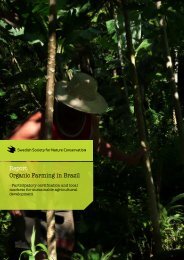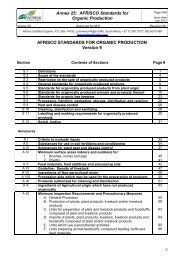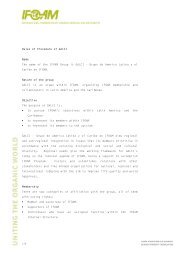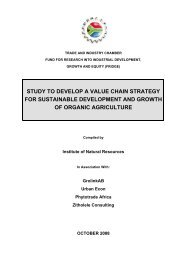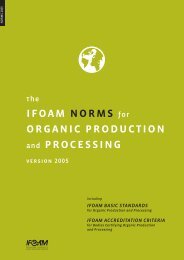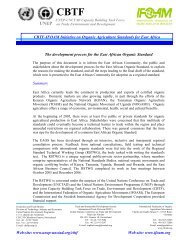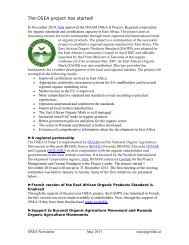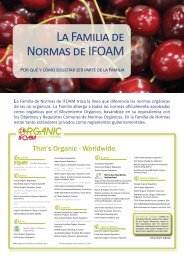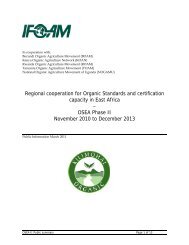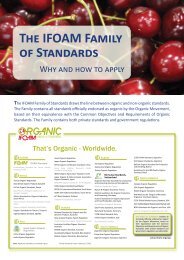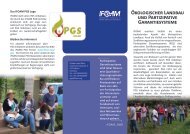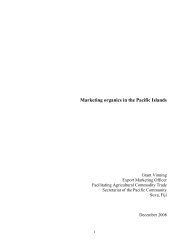Organic Farming in Kenya: A Growing Demand for ... - ifoam
Organic Farming in Kenya: A Growing Demand for ... - ifoam
Organic Farming in Kenya: A Growing Demand for ... - ifoam
Create successful ePaper yourself
Turn your PDF publications into a flip-book with our unique Google optimized e-Paper software.
<strong>Organic</strong> <strong>Farm<strong>in</strong>g</strong> <strong>in</strong> <strong>Kenya</strong>: A Grow<strong>in</strong>g <strong>Demand</strong> <strong>for</strong> Consistent Supply<br />
Figure1: Perimeter Shamba group members plow<strong>in</strong>g a plot <strong>for</strong> dry season, organic vegetables at<br />
Nyumbani Village, Kitui. 36 members of a Participatory Guarantee System (PGS) <strong>for</strong> organic<br />
certification collectively supply urban markets <strong>in</strong> Nairobi by stagger<strong>in</strong>g their production calendars.<br />
Prepared by John Sheffy, Program Manager<br />
GEM Susta<strong>in</strong>able Agriculture and Forestry Program (GEMSAF)<br />
Victor Phillips, GEM Director<br />
Global Environmental Management Education Center (GEM)<br />
University of Wiscons<strong>in</strong>—Stevens Po<strong>in</strong>t<br />
www.uwsp.edu/cnr/gem<br />
Summary: Dur<strong>in</strong>g May 2007, GEMSAF deployed two <strong>Kenya</strong>n and two UWSP<br />
Student Interns to work with organic farmers at Nyumbani Village. GEMSAF helped<br />
Nyumbani Village <strong>for</strong>malize their organization and record keep<strong>in</strong>g system <strong>for</strong> organic<br />
certification and create a cont<strong>in</strong>uous production and harvest calendar. GEMSAF met<br />
with key actors <strong>in</strong> the <strong>Kenya</strong> organic agriculture movement, <strong>in</strong>clud<strong>in</strong>g farmer tra<strong>in</strong><strong>in</strong>g<br />
<strong>in</strong>stitutions, market<strong>in</strong>g networks, NGO’s, and private bus<strong>in</strong>esses to facilitate the<br />
empowerment of small-scale community groups by this movement.<br />
1
I. <strong>Kenya</strong>n Partners<br />
Dur<strong>in</strong>g the first week of this trip, Philip Ndichu, GEMSAF <strong>Kenya</strong> Coord<strong>in</strong>ator, and John<br />
Sheffy met with GEM partners <strong>in</strong> Nairobi <strong>in</strong>clud<strong>in</strong>g: <strong>Kenya</strong> <strong>Organic</strong> Agriculture Network<br />
(KOAN), <strong>Kenya</strong> Institute of <strong>Organic</strong> <strong>Farm<strong>in</strong>g</strong> (KIOF), Nyumbani, Woodlands Trust<br />
2000, <strong>Kenya</strong> <strong>Organic</strong> Farmers (KOF), Bridges <strong>Organic</strong> Health Restaurant, and Green<br />
Dreams <strong>Organic</strong> Shop.<br />
The KOAN Secretariat, Eustace Kiarii, welcomed us to their office at the ICIPE/ELCI<br />
headquarters. KOAN has recently published the second issue of Kilimohai (Kiswahili <strong>for</strong><br />
organic farm<strong>in</strong>g) magaz<strong>in</strong>e, a publication dedicated to br<strong>in</strong>g<strong>in</strong>g together and <strong>in</strong><strong>for</strong>m<strong>in</strong>g<br />
actors <strong>in</strong> the <strong>Kenya</strong>n organic movement. This issue focuses on organic market<strong>in</strong>g and<br />
<strong>in</strong>cludes articles on Community-Supported Agriculture, CSA (or box schemes as they are<br />
called <strong>in</strong> the British world) and the advantages of direct market<strong>in</strong>g to green grocers and<br />
restaurants.<br />
KOAN has been busy recently develop<strong>in</strong>g a Kilimohai organic mark that farmers can<br />
apply <strong>for</strong> to display on their packag<strong>in</strong>g. They are also pioneer<strong>in</strong>g a centralized network<br />
and distribution system to help l<strong>in</strong>k farmers and buyers more easily. Although <strong>in</strong> its<br />
<strong>in</strong>itial stages, this system has the potential to <strong>in</strong>crease sales and consistency of supply by<br />
consolidat<strong>in</strong>g order<strong>in</strong>g and delivery with<strong>in</strong> the Nairobi market.<br />
KOAN is also organiz<strong>in</strong>g an organic farmers market <strong>in</strong> conjunction with the 100 th<br />
anniversary of the Nairobi Arboretum and Eco-week celebration <strong>in</strong> mid June. This will<br />
be the second organic farmers market KOAN has organized at the arboretum. They<br />
expect to host 40 farmers and producer groups and draw a crowd of over 2,000 customers.<br />
This promises to be an <strong>in</strong>spir<strong>in</strong>g event <strong>for</strong> up and com<strong>in</strong>g organic farmers and consumers<br />
alike.<br />
Figure 1: Maxwell K<strong>in</strong>yanjui (Woodlands Trust 2000), Mir<strong>in</strong>gu K<strong>in</strong>yanjui (GEM Intern), and Philip<br />
Ndichu (GEM In-country coord<strong>in</strong>ator) discuss susta<strong>in</strong>able dryland <strong>for</strong>est farm<strong>in</strong>g <strong>in</strong> Kitangela.<br />
2
While <strong>in</strong> Nairobi, Philip Ndichu and John Sheffy visited KIOF with DeNae Dandridge,<br />
GEM Student Ambassador. KIOF has recently accepted a large, new class of students <strong>for</strong><br />
both the two- and three-year certificate and diploma tracts. This br<strong>in</strong>gs the student<br />
population at the <strong>in</strong>stitute to nearly 100 <strong>in</strong>clud<strong>in</strong>g students actively study<strong>in</strong>g on the Juja<br />
campus and those on attachment <strong>in</strong> rural communities and regional tra<strong>in</strong><strong>in</strong>g centers. We<br />
were hosted to a tour of the KIOF student gardens and animal husbandry facilities. Each<br />
KIOF student manages a small plot (15x15m) where they implement and are scored on<br />
the organic production techniques they learn. We also viewed some of the food<br />
process<strong>in</strong>g equipment, such as a manual oil press, hay bailer, and solar dehydrator. KIOF<br />
is currently host<strong>in</strong>g an American volunteer on a Fulbright scholarship that is help<strong>in</strong>g with<br />
the Juja <strong>Organic</strong> Market. We thanked Dr. Njoroge <strong>for</strong> his cont<strong>in</strong>ued partnership with the<br />
GEMSAF program and supply<strong>in</strong>g another group of ambitious <strong>in</strong>terns <strong>for</strong> attachment.<br />
Figure 2: Dryland reclamation site near Kitangela us<strong>in</strong>g drip irrigated swales made of riparian<br />
harvested silt to establish woodlots on hardpan soils.<br />
We had the pleasure of visit<strong>in</strong>g with Maxwell K<strong>in</strong>yanjui, a consultant from Woodlands<br />
Trust 2000, at his re<strong>for</strong>estation woodlot <strong>in</strong> Kitangela. Figure 2 displays the tremendous<br />
growth of the <strong>for</strong>est <strong>in</strong> less than a decade where previously no trees grew. Maxwell<br />
described a project he and the Trust are work<strong>in</strong>g on near Kitangela <strong>for</strong> an organic farm<strong>in</strong>g<br />
tra<strong>in</strong><strong>in</strong>g center be<strong>in</strong>g <strong>in</strong>itiated by an Italian organization. Similar to Maxwell’s nearby<br />
woodlot and the Woodlands Trust 2000 dryland demonstration farm, the organic farm<strong>in</strong>g<br />
center will tra<strong>in</strong> farmers how to establish long-term <strong>in</strong>come crops like trees <strong>for</strong> fuelwood<br />
and timber, while <strong>in</strong>tercropp<strong>in</strong>g immediate food crops <strong>for</strong> consumption and market. The<br />
tra<strong>in</strong><strong>in</strong>g center is target<strong>in</strong>g adult pastoralists, primarily Masaii, <strong>for</strong> their first three-year<br />
curriculum. The tra<strong>in</strong><strong>in</strong>g course requires students to not only pass their courses and field<br />
practical, but also to actually prove their skills by harvest<strong>in</strong>g, sell<strong>in</strong>g, and return<strong>in</strong>g a<br />
profit to the center to partially cover their liv<strong>in</strong>g costs. Like Nyumbani Village, the<br />
organic farm<strong>in</strong>g tra<strong>in</strong><strong>in</strong>g center has begun establish<strong>in</strong>g jatropha trees as a source <strong>for</strong><br />
biodiesel oil.<br />
3
II. Nairobi <strong>Organic</strong> Markets<br />
The market <strong>for</strong> organic produce <strong>in</strong> Nairobi cont<strong>in</strong>ues to grow! On this trip, John Sheffy<br />
visited four ma<strong>in</strong> market locations, all of which reported expanded demand and<br />
difficulties f<strong>in</strong>d<strong>in</strong>g farmers to consistently supply organic products. The first three<br />
markets visited on previous trips were Juja <strong>Organic</strong> Market (KIOF), Green Dreams<br />
<strong>Organic</strong> Shop (Su Kahumbu), and Bridges <strong>Organic</strong> Health Restaurant (Ann Mbugua).<br />
Figure 3: Traditional <strong>Kenya</strong>n dishes made with delicious, organic <strong>in</strong>gredients and gourmet<br />
presentation at Bridges <strong>Organic</strong> Health Restaurant, <strong>in</strong> the Nairobi University and Bus<strong>in</strong>ess District,<br />
Tubman Road.<br />
The Juja <strong>Organic</strong> Market has overhauled its previous market<strong>in</strong>g strategy, which asked<br />
organic farmers to deliver their products to its headquarters and organic buyers and<br />
distributors to come to the shop and buy <strong>for</strong> redistribution. Now the Juja market goes to<br />
the farmers once a week to collect produce, then repacks produce from many different<br />
farms <strong>in</strong>to box schemes, and delivers them to subscribers <strong>in</strong> Nairobi. This has <strong>in</strong>creased<br />
their sales of produce significantly and provides a more regular market <strong>for</strong> their farmers.<br />
The fourth market, KOFF Farmers Group, is a distribution service of produce that<br />
organizes the order, delivery, sort<strong>in</strong>g, and re-delivery to specific outlets like restaurants,<br />
green grocers, and <strong>in</strong>dividual box scheme members. Each week the staff of KOFF<br />
contact buyers <strong>for</strong> their orders and relay these orders to farmers on their list. This list of<br />
farmers came from members of the <strong>Kenya</strong> <strong>Organic</strong> Agriculture Network (KOAN). With<br />
large orders <strong>for</strong> some products, KOFF often has to source items from multiple farms,<br />
coord<strong>in</strong>ate the delivery to Nairobi, where they then collect and consolidate the products<br />
<strong>for</strong> f<strong>in</strong>al delivery. Alternatively, when one farmer or group has an excess of items, KOFF<br />
will also order <strong>in</strong> bulk and divide the produce and distribute to multiple buyers. For this<br />
service, KOFF charges a service fee to the farmers to cover their costs of transport, store<br />
rent, and employees.<br />
There are many concerns among the organic market <strong>in</strong> Nairobi. Foremost is the need <strong>for</strong><br />
more consistent supply of high quality organic produce. All four markets lamented<br />
hav<strong>in</strong>g good products sporadically— never know<strong>in</strong>g when or how long someth<strong>in</strong>g will be<br />
available. This is primarily because most farmers plant and harvest crops <strong>for</strong> one<br />
plant<strong>in</strong>g and harvest event, rather than cont<strong>in</strong>uous propagation. Either more tra<strong>in</strong><strong>in</strong>g is<br />
needed <strong>for</strong> <strong>in</strong>dividual farmers to perpetuate their harvest of cont<strong>in</strong>ually needed items, or<br />
4
more coord<strong>in</strong>ation between farmer groups needs to be organized <strong>for</strong> their production to<br />
complement rather than compete with each other.<br />
Another concern, particularly with Green Dreams, is that farmers need to become<br />
certified to <strong>in</strong>sure quality organic produce. Of the KOAN and Juja farmer groups, very<br />
few are actually certified organic. When a large percentage of the organic purchas<strong>in</strong>g<br />
population is expatriates and <strong>Kenya</strong>ns that understand and expect “organic” to meet<br />
certa<strong>in</strong> standards, it is critical that the farmers are <strong>in</strong>deed meet<strong>in</strong>g these production<br />
criteria <strong>in</strong> order to susta<strong>in</strong> the demand.<br />
F<strong>in</strong>ally, a concern among all players <strong>in</strong> the organic market is that it is a susta<strong>in</strong>able<br />
market that cont<strong>in</strong>ues to grow and be profitable <strong>for</strong> all members of the market cha<strong>in</strong>. The<br />
birth of KOFF as a distribution service br<strong>in</strong>gs to light several <strong>in</strong>terest<strong>in</strong>g ideas. Is a<br />
coord<strong>in</strong>ation role sufficiently important and needed by the farmers and buyers to<br />
necessitate a new member <strong>in</strong> the market cha<strong>in</strong> like KOFF? Are the operational costs<br />
realized by KOFF justified by the ga<strong>in</strong>s <strong>in</strong> <strong>in</strong>creased sales? In other words, is the price of<br />
the service paid by the farmers worth it? In order <strong>for</strong> the markets to be susta<strong>in</strong>able, they<br />
must be as transparent as possible and run like true bus<strong>in</strong>esses, not reliant on donor funds<br />
<strong>for</strong> pay<strong>in</strong>g salaries or subsidies. With a rapidly expand<strong>in</strong>g and high-value organic sector<br />
<strong>in</strong> <strong>Kenya</strong>, there is no reason why this is not possible.<br />
III. Nyumbani Village (Week 1)<br />
Figure 4: One of the 32 families now liv<strong>in</strong>g at Nyumbani Village, June 2007. As the population<br />
approaches 150 residents, the village rattles and hums like its surround<strong>in</strong>g neighbors, br<strong>in</strong>g<strong>in</strong>g the<br />
vision to life.<br />
Nyumbani Village is a model community <strong>for</strong> capacity build<strong>in</strong>g and socialization of<br />
HIV/AIDS orphaned children and elderly. The village rests on 1,000 acres of drylands <strong>in</strong><br />
Kitui District. The village population will eventually <strong>in</strong>clude approximately 1,000<br />
5
orphaned children and 200 elderly grandparents. Staff <strong>for</strong> a community health cl<strong>in</strong>ic,<br />
school, social workers, and natural resource management will also reside at the village.<br />
The vision <strong>for</strong> this population is to create a healthy, empower<strong>in</strong>g community where all<br />
residents work together to <strong>in</strong>crease quality of life through susta<strong>in</strong>able and harmonious<br />
liv<strong>in</strong>g. Villagers will reclaim their health and self esteem while also learn<strong>in</strong>g dryland<br />
land management and trade skills to employ <strong>in</strong> their homes when they leave the village.<br />
The village also plans to serve as a social and economic hub <strong>for</strong> the surround<strong>in</strong>g<br />
communities, <strong>in</strong>clud<strong>in</strong>g the schools, health care facilities, and agriculture activities.<br />
The management of Nyumbani Village is composed pr<strong>in</strong>cipally of two components:<br />
Home Care and Susta<strong>in</strong>ability. Home Care tends to the needs of the human population,<br />
while Susta<strong>in</strong>ability manages the village lands. This document outl<strong>in</strong>es the request <strong>for</strong><br />
organic certification of Nyumbani Village <strong>for</strong> three primary objectives: 1) To feed the<br />
village population with nutritious, susta<strong>in</strong>ably grown foods, 2) To generate <strong>in</strong>come by<br />
sell<strong>in</strong>g fresh, organic produce and value-added products to high-value niche markets <strong>in</strong><br />
Nairobi, and 3) To tra<strong>in</strong> villagers and surround<strong>in</strong>g community members to grow organic<br />
products <strong>for</strong> home consumption and sale. To accomplish these objectives, the Nyumbani<br />
Susta<strong>in</strong>ability Program will oversee and ma<strong>in</strong>ta<strong>in</strong> organic production and record keep<strong>in</strong>g,<br />
while tra<strong>in</strong><strong>in</strong>g and <strong>in</strong>corporat<strong>in</strong>g villagers and community members <strong>in</strong>to the village<br />
organic production scheme.<br />
GEMSAF has been work<strong>in</strong>g with Nyumbani Village s<strong>in</strong>ce May 2006 by provid<strong>in</strong>g<br />
technical consult<strong>in</strong>g, <strong>Kenya</strong>n and UWSP student <strong>in</strong>terns, and strategic support <strong>for</strong> project<br />
organization and market<strong>in</strong>g campaigns. Dur<strong>in</strong>g John Sheffy’s last visit to Nyumbani<br />
Village <strong>in</strong> December 2006, the first two families had just moved <strong>in</strong>. In June 2007 the<br />
village population is approximately 150, <strong>in</strong>clud<strong>in</strong>g 32 families! The grow<strong>in</strong>g population<br />
has re<strong>in</strong>vigorated the surround<strong>in</strong>g community to support the village and accentuated the<br />
need <strong>for</strong> susta<strong>in</strong>able food production and <strong>in</strong>come generation. To help with this,<br />
GEMSAF deployed two <strong>Kenya</strong>n and two UWSP students to work at the village.<br />
Figure 5: DeNae Dandridge, one of the UWSP-GEM students, visit<strong>in</strong>g a six-month old acacia woodlot<br />
at Nyumbani Village. The densely planted, <strong>in</strong>digenous trees are excellent <strong>for</strong> fuel wood and charcoal.<br />
6
The UWSP students work<strong>in</strong>g at Nyumbani Village are part of the GEM Student<br />
Ambassador Program where students from the College of Natural Resources apply <strong>for</strong><br />
specific project assignments with GEM <strong>for</strong>eign partners to help fulfill community- based<br />
tra<strong>in</strong><strong>in</strong>g and applied research needs of collaborative projects while promot<strong>in</strong>g crosscultural<br />
exchange. Besides <strong>Kenya</strong>, GEM sent UWSP students to India, Ch<strong>in</strong>a, South<br />
Africa, and Guatemala this summer to work <strong>in</strong> the field with GEM partner <strong>in</strong>stitutions.<br />
DeNae Dandridge is a GEM graduate student study<strong>in</strong>g susta<strong>in</strong>able agriculture systems at<br />
UWSP. Her thesis research <strong>in</strong> Wiscons<strong>in</strong> explores l<strong>in</strong>k<strong>in</strong>g farmers to direct markets. In<br />
<strong>Kenya</strong> she is work<strong>in</strong>g with community groups and Nyumbani Village residents on food<br />
process<strong>in</strong>g techniques <strong>in</strong>clud<strong>in</strong>g yogurt and butter mak<strong>in</strong>g, bread and cake bak<strong>in</strong>g,<br />
dehydrat<strong>in</strong>g fruits and vegetables, and preserv<strong>in</strong>g vitam<strong>in</strong>-rich fruits as jams and juices<br />
<strong>for</strong> home consumption. To cook these delicious recipes, DeNae first tra<strong>in</strong>ed participants<br />
<strong>in</strong> build<strong>in</strong>g high-efficiency, mud-walled cook stoves (jikos). Her <strong>in</strong>terest and knowledge<br />
of food goes beyond research; she also shares many personal and traditional recipes.<br />
Dur<strong>in</strong>g this trip DeNae planned her tra<strong>in</strong><strong>in</strong>g schedule to <strong>in</strong>clude two, half-day workshops<br />
each week as well as regular home visits to learn traditional <strong>Kenya</strong>n cook<strong>in</strong>g and food<br />
preservation techniques. DeNae will be work<strong>in</strong>g at Nyumbani Village <strong>for</strong> eleven weeks.<br />
Figure 6: Millicent Musau, a <strong>Kenya</strong>n-GEM Intern, work<strong>in</strong>g on an organic records card with a<br />
Perimeter Shamba farmer. Rose keep records of all <strong>in</strong>puts, harvests, and management activities on<br />
her parcel as part of the Nyumbani <strong>Organic</strong> Certification System.<br />
Millicent Musau is a GEM student <strong>in</strong>tern from the <strong>Kenya</strong> Institute of <strong>Organic</strong> <strong>Farm<strong>in</strong>g</strong>.<br />
She is orig<strong>in</strong>ally from the Machakos District near Nyumbani Village, and there<strong>for</strong>e<br />
understands the local culture and speaks the local language, Kikamba. She recently<br />
f<strong>in</strong>ished her coursework <strong>for</strong> the <strong>Organic</strong> <strong>Farm<strong>in</strong>g</strong> Diploma at KIOF and will be on<br />
attachment under GEM <strong>for</strong> four months at Nyumbani Village. Her assignment <strong>in</strong>cludes<br />
7
work<strong>in</strong>g with the Perimeter Shamba group to produce dry season organic vegetables <strong>for</strong><br />
home consumption and collective sale under the Nyumbani <strong>Organic</strong> Certification System.<br />
She has been tra<strong>in</strong><strong>in</strong>g farmers <strong>in</strong> record keep<strong>in</strong>g, soil amendment techniques,<br />
<strong>in</strong>tercropp<strong>in</strong>g, pest management and biopesticides, and how to grow unfamiliar<br />
vegetables. After only one month, the Perimeter Shamba group looks to Milicenth <strong>for</strong><br />
advice be<strong>for</strong>e <strong>in</strong>itiat<strong>in</strong>g any activities on their half-acre parcels.<br />
The Perimeter Shamba system is one of the most encourag<strong>in</strong>g signs of commitment from<br />
the surround<strong>in</strong>g community to Nyumbani Village. Dur<strong>in</strong>g this trip several of the group<br />
members brought their own oxen to the village to voluntarily plow village land to grow<br />
vegetables. This is <strong>in</strong> stark contrast to wait<strong>in</strong>g <strong>for</strong> the village to provide oxen or tractor<br />
power to prepare the lands and expect<strong>in</strong>g to be paid <strong>in</strong> advance to work on village<br />
activities, as had been common <strong>in</strong> the past. This is a sign that the surround<strong>in</strong>g<br />
community is embrac<strong>in</strong>g the Nyumbani vision as a shared vision and sees their stake <strong>in</strong><br />
the success of susta<strong>in</strong>able land use!<br />
Figure 7: Felix Gitonga, Nyumbani Village Foreman, discusses plans <strong>for</strong> compost mak<strong>in</strong>g with Joel, a<br />
community member work<strong>in</strong>g on organic vegetables and food process<strong>in</strong>g. Felix spends his time on the<br />
move from one production area of the village to another to keep th<strong>in</strong>gs go<strong>in</strong>g smoothly.<br />
Dur<strong>in</strong>g the week at Nyumbani Village to <strong>in</strong>troduce the GEM student <strong>in</strong>terns, John Sheffy<br />
worked with Philip Ndichu and the Nyumbani Susta<strong>in</strong>ability Managers, George Mirie<br />
and Felix Gitonga, to <strong>for</strong>malize their organic certification record-keep<strong>in</strong>g system and<br />
organize their production calendar <strong>for</strong> consistent food production.<br />
All 1,000 acres of Nyumbani Village are be<strong>in</strong>g organically managed and are be<strong>in</strong>g<br />
targeted <strong>for</strong> certification. Records show that no synthetic <strong>in</strong>puts, or other products and<br />
practices prohibited by organic standards, have been applied to the land s<strong>in</strong>ce its<br />
development as Nyumbani Village began <strong>in</strong> 2005. There is no reason to believe there<br />
8
were any prohibited products or practices applied to this land prior to this as well, based<br />
on its uncultivated bushland state.<br />
In the future, Nyumbani Village aspires to serve the surround<strong>in</strong>g communities as a<br />
collection, process<strong>in</strong>g, and market<strong>in</strong>g center <strong>for</strong> organic producers. It is the long-term<br />
goal to certify these outrgrowers and their lands as organic under a Participatory<br />
Guarantee System (PGS). In such a system, Nyumbani will <strong>in</strong>spect the outgrowers’<br />
techniques, records, and lands. When the village is certified, its system of outgrower<br />
<strong>in</strong>spection will also be <strong>in</strong>spected and certified without all <strong>in</strong>dividual outgrowers need<strong>in</strong>g<br />
to apply <strong>for</strong> certification. However, this document requests only the certification <strong>for</strong><br />
Nyumbani lands <strong>for</strong> the year 2007/2008.<br />
The majority of Nyumbani Village lands are managed as woodlands, which are be<strong>in</strong>g<br />
re<strong>for</strong>ested <strong>for</strong> production of fuelwood, charcoal, and other non-timber <strong>for</strong>est products,<br />
like beekeep<strong>in</strong>g and wild, medic<strong>in</strong>al plant collection. The m<strong>in</strong>ority of lands are actively<br />
be<strong>in</strong>g managed <strong>for</strong> vegetable, cereal, and biofuel production. The follow<strong>in</strong>g production<br />
areas will be described <strong>in</strong> more detail <strong>for</strong> their management plans, production cycles, and<br />
organic record keep<strong>in</strong>g systems.<br />
Perimeter Project Land Layout<br />
Ma<strong>in</strong> Road<br />
Water Tanks<br />
Individual Plot Individual Plot Individual Plot Individual Plot<br />
20M<br />
Road to<br />
the<br />
Village<br />
Individual Plot<br />
Individual Plot<br />
Ox Road<br />
5M<br />
Individual Plot Individual Plot Individual Plot Individual Plot Individual Plot<br />
20M<br />
Individual Plot<br />
Ox Road<br />
Individual Plot<br />
Ra<strong>in</strong>fed<br />
35M<br />
Individual Plot<br />
Individual Plot<br />
Individual Plot<br />
Figure 8 Diagram of Perimeter Shamba Production Areas<br />
Production Areas:<br />
‣ Perimeter Shambas<br />
‣ Ma<strong>in</strong> Farm<br />
‣ Riparian<br />
‣ Home Gardens<br />
‣ Carbon <strong>Farm<strong>in</strong>g</strong><br />
‣ Wild Harvest<br />
‣ Polytechnic<br />
‣ Agro Process<strong>in</strong>g<br />
‣ Tree Nursery<br />
‣ Essential Oils<br />
‣ Waste Management<br />
‣ Visitors<br />
9
‣ Collection and Storage Area ‣ Compost, Biofertilizers, and<br />
‣ Vegetable Seedl<strong>in</strong>g Propagation<br />
Biopesticides<br />
‣ Transportation<br />
Record Keep<strong>in</strong>g:<br />
All Nyumbani Village production areas and activities fall under the supervision and<br />
management of the village Susta<strong>in</strong>ability Program. For organic certification, the<br />
Susta<strong>in</strong>ability Program serves as the central record-keep<strong>in</strong>g and plann<strong>in</strong>g body <strong>for</strong> the<br />
satellite production area records and activities. The Susta<strong>in</strong>ability Program records<br />
<strong>in</strong>clude a map of all village lands, production areas, and management plans. Central<br />
rerecords are kept <strong>in</strong> an excel spreadsheet, which is updated weekly and analyzed<br />
monthly and quarterly <strong>for</strong> report<strong>in</strong>g and plann<strong>in</strong>g activities.<br />
Each production area keeps <strong>in</strong>dividual records of all activities, <strong>in</strong>puts, outputs, and<br />
management plans. Individual production area records are kept <strong>in</strong> b<strong>in</strong>ders specific to<br />
each area, which <strong>in</strong>clude detailed maps of all production blocks and sub-blocks with<strong>in</strong><br />
each production areas. For example see the template <strong>for</strong> record keep<strong>in</strong>g of the Perimeter<br />
Shamba Areas:<br />
Date<br />
Plot<br />
No.<br />
1<br />
2<br />
3<br />
4<br />
5<br />
Name<br />
of<br />
Holder<br />
Perimeter Sub-Project Records<br />
Name (person <strong>in</strong> charge)<br />
Activities Inputs Quantities Outputs Quantities<br />
Figure 9 Record keep<strong>in</strong>g template designed to summarize activities of each<br />
<strong>in</strong>dividual Perimeter Shamba member.<br />
All contracted staff, casual workers, and community members work<strong>in</strong>g on Nyumbani<br />
Village lands are tra<strong>in</strong>ed to record all production activities. Record b<strong>in</strong>ders are checked<br />
regularly by the Susta<strong>in</strong>ability Program managers. Note that process<strong>in</strong>g, packag<strong>in</strong>g, and<br />
transportation are each considered specific production areas at Nyumbani Village, and<br />
thus have their own record b<strong>in</strong>ders. This was done to facilitate the accountability of<br />
record keep<strong>in</strong>g when products pass through multiple worker’s hands from seedl<strong>in</strong>g<br />
propagation to field to harvest and process<strong>in</strong>g.<br />
Production Activities:<br />
10
The target quantities of organic production are based on the weekly consumption<br />
estimated <strong>for</strong> the village population and community members work<strong>in</strong>g <strong>in</strong> the farms, as<br />
well as the weekly demand of organic markets <strong>in</strong> Nairobi. The Susta<strong>in</strong>ability Program<br />
estimated the number of plants needed to supply this weekly demand. For example, three<br />
stems of tomatoes will produce approximately 1kg of tomatoes per week dur<strong>in</strong>g their four<br />
week peak production period. Thus, every month a new crop of tomatoes will be<br />
propagated <strong>in</strong> the vegetable nursery and transplanted <strong>in</strong>to various production areas to<br />
ma<strong>in</strong>ta<strong>in</strong> a cont<strong>in</strong>uous production and harvest cycle <strong>for</strong> all vegetables.<br />
Crop<br />
Plant 1st<br />
Crop<br />
#<br />
plants/ridge<br />
Number of<br />
ridges<br />
Total #<br />
plants<br />
Maturation<br />
period<br />
Harvest<br />
Date<br />
Tomatoes 15-May 77 4 308 85 days 9-Aug<br />
Swiss Chard 15-May 116 3 348 60 days 10-Jul<br />
Sp<strong>in</strong>ach 15-May 116 3 348 60 days 10-Jul<br />
Butternuts 15-May 6 1 6 90 days 15-Aug<br />
Pumpk<strong>in</strong>s 15-May 6 1 6 90 days 15-Aug<br />
Watermelons 15-May 6 1 6 90 days 15-Aug<br />
Onions 15-May 466 1 466 65 days 20-Jul<br />
Crop<br />
Plant<br />
2nd<br />
Crop<br />
Harvest<br />
Date<br />
Plant 3rd<br />
Crop<br />
Harvest<br />
Date<br />
Plant 4th<br />
crop<br />
Harvest<br />
Date<br />
Tomatoes 18-Jun 13-Sep 23-Jul 18-Oct 27-Aug 22-Nov<br />
Swiss Chard 12-Jun 7-Aug 10-Jul 10-Sep 10-Aug 10-Oct<br />
Sp<strong>in</strong>ach 12-Jun 7-Aug 10-Jul 10-Sep 10-Aug 10-Oct<br />
Butternuts 15-Jun 15-Sep 15-Jul 15-Oct 15-Aug 15-Nov<br />
Pumpk<strong>in</strong>s 15-Jun 15-Sep 15-Jul 15-Oct 15-Aug 15-Nov<br />
Watermelons 15-Jun 15-Sep 15-Jul 15-Oct 15-Aug 15-Nov<br />
Onions 22-May 27-Jul 5-Jun 3-Aug 12-Jun 10-Aug<br />
Figure 10 Estimated number of plants to germ<strong>in</strong>ate per ridge, per harvest cycle<br />
based on the market demand <strong>for</strong> a cont<strong>in</strong>uous supply of organic produce.<br />
With the number of weekly and monthly transplants estimated, the Susta<strong>in</strong>ability<br />
Program calculated the total surface area of each production area to determ<strong>in</strong>e the density<br />
of plant<strong>in</strong>g of each crop <strong>in</strong> diverse polyculture systems. For example, a square meter of<br />
drip-irrigated ridge can grow approximately two tomatoes, peppers, or eggplants, which<br />
are surrounded by smaller lower-grow<strong>in</strong>g onions, collards, coriander, and sp<strong>in</strong>ach.<br />
F<strong>in</strong>ally, v<strong>in</strong>e crops like sweet potatoes, melons, butternuts, and cucumbers are grown on<br />
the side of the beds as runners. These polyculture systems maximize diversity to reduce<br />
pest and disease problems, build soil fertility and diverse microbial life, and maximize<br />
use of production space horizontally and vertically by utiliz<strong>in</strong>g all grow<strong>in</strong>g horizons.<br />
Some production blocks, such as the ma<strong>in</strong> farm, are watered us<strong>in</strong>g drip irrigation, while<br />
others are hand irrigated, like the perimeter shambas. Some lands are prepared by tractor,<br />
oxen plow, and hand cultivation. All weed<strong>in</strong>g and harvest is done by hand. All<br />
croplands are supplemented by the application of compost made at the village, and<br />
biofertilizers and biopesticides made at the village from local and purchased <strong>in</strong>gredients.<br />
11
Products are packed <strong>in</strong> plastic crates and bags, cushioned <strong>for</strong> transportation with organic<br />
straw. Products are transported <strong>in</strong> a Nyumbani Village vehicle, which is primarily used<br />
<strong>for</strong> weekly organic produce delivery. When not <strong>in</strong> use <strong>for</strong> organic delivery, records <strong>for</strong><br />
use will be kept and appropriate clean<strong>in</strong>g will be done if non organic products come <strong>in</strong><br />
contact with the produce area. The vehicle will run on Village produced biodiesel fuel<br />
with<strong>in</strong> five years.<br />
Figure 11: Example of polyculture beds at Nyumbani Village with beans, tomatoes, maize, and other<br />
vegetables.<br />
Figure 12 Close up view of polyculture bed at UWSP with radishes, collards, peas, carrots, onions,<br />
kale, beets, lettuce, and flowers.<br />
12
Markets <strong>for</strong> organic products <strong>in</strong> Nairiobi are managed by the Nyumbani Village<br />
Susta<strong>in</strong>ability Manager and consultants who deliver produce to <strong>in</strong>dividual organic outlets,<br />
<strong>in</strong>clud<strong>in</strong>g restaurants and green grocers. Records are kept of all quantities transported,<br />
sold, prices, and payments received. Prices are determ<strong>in</strong>ed <strong>for</strong>emost by the cost of<br />
production, which guarantees that the sale price will allow Nyumbani Village to<br />
susta<strong>in</strong>ably care <strong>for</strong> the land and pay all workers a fair wage.<br />
IV. Egerton University and Kamweti Village<br />
Prior to this trip, GEMSAF planned <strong>for</strong> two GEM <strong>in</strong>terns to work <strong>in</strong> Kamweti Village<br />
with the Karumandi St<strong>in</strong>g<strong>in</strong>g Nettle and Beekee<strong>in</strong>g Group. These plans built upon the<br />
past year of workshops and field tra<strong>in</strong><strong>in</strong>g activities of GEM with this community. In<br />
December, the group identified beekeep<strong>in</strong>g, enhanced dairy production, and organic<br />
vegetables as its desires <strong>for</strong> tra<strong>in</strong><strong>in</strong>g and small bus<strong>in</strong>ess development <strong>in</strong> 2007.<br />
However, <strong>in</strong> April 2007, Dr. Samuel Kariuki of Egerton University re-<strong>in</strong>itiated contact<br />
with GEM to <strong>in</strong><strong>for</strong>m us that he would have to oversee the GEM <strong>in</strong>ternships and activities<br />
at Kamweti Village because he was the “Patron” or the official that <strong>in</strong>itiated the group.<br />
At that time he conv<strong>in</strong>ced the group’s Chairman that this would be <strong>in</strong> the group’s best<br />
<strong>in</strong>terest <strong>for</strong> this and future projects to go through him and Egerton University. Accord<strong>in</strong>g<br />
to his request, GEM delayed deployment of the two KIOF organic farm<strong>in</strong>g and animal<br />
husbandry students <strong>for</strong> Dr. Kariuki to meet with the community group. However,<br />
follow<strong>in</strong>g one and a half months, Kariuki had not yet met the group and the KIOF<br />
students subsequently found other attachment projects.<br />
Dur<strong>in</strong>g this trip, Philip Ndichu and John Sheffy met with Kariuki at both Egerton<br />
University campus and with group members at Kamweti. Un<strong>for</strong>tunately, Dr. Kariuki<br />
refused to release his control over the group to allow them to work directly with GEM <strong>in</strong><br />
a project that the community group had def<strong>in</strong>ed accord<strong>in</strong>g to their <strong>in</strong>terests. Rather,<br />
Kariuki conv<strong>in</strong>ced the group that <strong>in</strong> order to cont<strong>in</strong>ue with the project, he would need to<br />
facilitate an official agreement between GEM and Egerton University. He said this was<br />
<strong>for</strong> liability reasons <strong>for</strong> himself and Egerton University, not because of any issues with<br />
the GEM project activities or the Kamweti community. Un<strong>for</strong>tunately, Dr. Kariuki has<br />
not shown any genu<strong>in</strong>e ef<strong>for</strong>t to make progress on any such agreement s<strong>in</strong>ce this trip. In<br />
fact, GEM proposed a <strong>for</strong>mal agreement and contract with Egerton University on this<br />
project <strong>in</strong> June 2006, which <strong>for</strong> over a year has received no attention or response.<br />
Because of this problem, GEM has been <strong>for</strong>ced to focus our ef<strong>for</strong>ts on will<strong>in</strong>g<br />
partnerships <strong>in</strong> <strong>Kenya</strong>, such as Nyumbani Village, other than Egerton University.<br />
V. Nyumbani Village (Week 2)<br />
Follow<strong>in</strong>g the un<strong>for</strong>tunate circumstances at Kamweti Village, John Sheffy returned to<br />
Nyumbani Village to reassign Seth Lenaerts to work with the susta<strong>in</strong>ability program as<br />
well as home resource use with the families.<br />
13
Figure 9: Nyumbani Village grandparents gather daily to share the milk harvested from the village<br />
cows. The women also meet regularly to weave traditional Kyondo baskets and share cook<strong>in</strong>g<br />
responsibilities, develop<strong>in</strong>g strong community bonds <strong>in</strong> their new family and hous<strong>in</strong>g situations.<br />
Seth Lenaerts is study<strong>in</strong>g land use plann<strong>in</strong>g and soils at UWSP. In <strong>Kenya</strong> he will focus<br />
his work on mapp<strong>in</strong>g land use areas of the village susta<strong>in</strong>ability program to facilitate the<br />
record keep<strong>in</strong>g system <strong>for</strong> organic certification and prioritize areas <strong>for</strong> development. The<br />
Susta<strong>in</strong>ability Program consists of over twenty production units, from agro<strong>for</strong>estry to<br />
waste management. Seth will be mapp<strong>in</strong>g the flow of energy and resources from one<br />
production area to another to conserve and <strong>in</strong>crease efficiency. Seth also works <strong>in</strong><br />
communications at UWSP, where he organizes campus enterta<strong>in</strong>ment events. This will<br />
undoubtedly enhance the cultural exchange elements of his experience. Seth will be at<br />
Nyumbani Village <strong>for</strong> fifteen weeks this summer.<br />
In conjunction with the home care program, Seth and John Sheffy also designed a project<br />
<strong>for</strong> him to develop four model homes that efficiently reduce, reuse, and recycle<br />
household resources. Seth’s activities will <strong>in</strong>clude build<strong>in</strong>g high-efficiency mud cook<br />
stoves (jikos) to reduce fuel wood consumption and time needed <strong>for</strong> cook<strong>in</strong>g. He will<br />
also be develop<strong>in</strong>g grey-water recycl<strong>in</strong>g systems to filter out soap and solid wastes be<strong>for</strong>e<br />
apply<strong>in</strong>g water to home gardens. With each house he will build a compost site <strong>for</strong><br />
separat<strong>in</strong>g organic waste. Seth also plans to experiment with square meter gardens us<strong>in</strong>g<br />
three locally available soil types: black cotton, riparian silt, and upland red soil. He will<br />
collect production data <strong>for</strong> common vegetable crops, us<strong>in</strong>g the four households as<br />
replications.<br />
14
Figure 14: Seth Lenaerts stomp<strong>in</strong>g mud made from highly durable termite mound soil to make a<br />
high efficiency cook stove. Seth is work<strong>in</strong>g here at one of the village family homes with three sisters<br />
from <strong>Kenya</strong>, Tanzania, and Rwanda who are also volunteer<strong>in</strong>g at Nyumbani Village.<br />
Dur<strong>in</strong>g this week at Nyumbani Village, Nicholas Syano set up a tree seedl<strong>in</strong>g<br />
germ<strong>in</strong>ation and growth rate experimental plot. Nicholas is a GEMSAF graduate student<br />
writ<strong>in</strong>g his M.S. thesis on small garden systems and carbon farm<strong>in</strong>g <strong>for</strong> <strong>in</strong>creas<strong>in</strong>g<br />
household nutrition and fuel as well as <strong>in</strong>come generation. Based on his review of<br />
dryland agro<strong>for</strong>estry literature, he selected five tree species known <strong>for</strong> their high fuel<br />
wood, charcoal, and agro<strong>for</strong>estry value. Dur<strong>in</strong>g this field season <strong>in</strong> <strong>Kenya</strong>, Nicholas is<br />
also collaborat<strong>in</strong>g with the <strong>Kenya</strong> Forestry Research Institute (KEFRI) to adapt their<br />
research to the small-scale household level.<br />
Figure 15: Nicholas Syano, GEMSAF grad student, set up this dryland tree species propagation<br />
experiment at Nyumbani Village. The trials test the germ<strong>in</strong>ation and growth rates of five locally<br />
adapted tree species of high value <strong>for</strong> fuelwood, charcoal, and other agro<strong>for</strong>estry uses.<br />
15
Figure 1610: Students from Syracuse, New York, build a mud jiko at the Nyumbani Village Primary<br />
School <strong>for</strong> mak<strong>in</strong>g daily uji (porridge) <strong>for</strong> over 50 primary students! The new stove will save fuel,<br />
cook faster, buffer the fire, and direct smoke away from the cook.<br />
F<strong>in</strong>ally, dur<strong>in</strong>g this week John Sheffy had the pleasure of guid<strong>in</strong>g a group of students and<br />
faculty from Le Moyne College <strong>in</strong> Syracuse, NY to Nyumbani Village. This group was<br />
excited to get <strong>in</strong>volved <strong>in</strong> the farm<strong>in</strong>g activities and spent the whole week <strong>in</strong> the field<br />
alongside Nyumbani staff, community members, and GEM <strong>in</strong>terns. Among their many<br />
activities, the students planted and watered trees <strong>in</strong> the perimeter shamba area, cleared<br />
brush <strong>for</strong> a new oxen road to deliver water to the perimeter shambas, and helped build<br />
eight household mud jikos. The student group greatly enjoyed their short time at the<br />
village. This type of program represents a potential source of energetic volunteer labor<br />
and <strong>in</strong>come <strong>for</strong> the village, as well as excellent publicity to attract donor support and<br />
partners.<br />
Figure 17: A fresh mud walled jiko next to the open 3-stone fire. Grandparents at Nyumbani Village<br />
love the new stoves and are construct<strong>in</strong>g them across the village.<br />
16
VI. Next Steps<br />
1) Solidify the production calendar and propagation system at Nyumbani<br />
Village to satisfy the weekly demand <strong>for</strong> village consumption and market<br />
vegetables. The weekly and monthly seedl<strong>in</strong>g propagation system we<br />
designed needs to be carefully implemented. Precise data should be kept so<br />
the estimated number of seedl<strong>in</strong>gs needed to harvest a certa<strong>in</strong> quantity can be<br />
further honed <strong>for</strong> accuracy. John Sheffy has asked Philip Ndichu to take on<br />
this extra responsibility to make sure this program gets up and runn<strong>in</strong>g quickly.<br />
2) Recruit 3 rd <strong>Kenya</strong>n <strong>in</strong>tern <strong>for</strong> Home Care/Susta<strong>in</strong>ability activities. With<br />
the rapidly ris<strong>in</strong>g village population putt<strong>in</strong>g stress on the village management<br />
systems, it is a critical priority to establish sound environmental policies and<br />
practices at the household level to reduce waste and promote susta<strong>in</strong>ability.<br />
GEMSAF proposes to recruit an <strong>in</strong>tern from Jomo <strong>Kenya</strong>tta University of<br />
Agriculture and Technology (JKAT) to work <strong>in</strong> collaboration with the<br />
homecare and social workers that work with the families. This <strong>in</strong>tern will<br />
work on grey-water recycl<strong>in</strong>g, fuel wood management and jikos, home<br />
gardens, home shambas, and prepar<strong>in</strong>g the homes <strong>for</strong> chickens and dairy goats.<br />
It is very important to <strong>in</strong>still a sense of conservation among the families<br />
<strong>in</strong>itially, to reduce the creation of waste and over use of water, and also<br />
encourage them to be as productive and self-sufficient as possible.<br />
3) Request organic certification <strong>for</strong> Nyumbani Village from EnCert (<strong>Kenya</strong>n<br />
organic certification body) and fix a date <strong>for</strong> <strong>in</strong>spection. Now that the village<br />
has an overall map and management vision <strong>for</strong> all production areas and<br />
<strong>in</strong>dividual record keep<strong>in</strong>g systems <strong>in</strong> place, it is ready to be <strong>in</strong>spected. The<br />
certifier will most likely have comments and suggestions on how to improve<br />
the organic management system, which should be <strong>in</strong>corporated. The only<br />
additional <strong>in</strong><strong>for</strong>mation that could help facilitate the certification would be past<br />
records from the land acquisition and construction periods show<strong>in</strong>g that no<br />
prohibited substances and practices were used at the village. This could<br />
shorten the conversion period. There is no reason to delay <strong>in</strong>itiat<strong>in</strong>g the<br />
<strong>in</strong>spection and certification process as this is a requirement to access the high<br />
value organic vegetable markets <strong>in</strong> Nairobi.<br />
4) Investigate the assets and challenges of the Nairobi organic market. Look<br />
closely at the costs and benefits to different actors <strong>in</strong> the market and the<br />
strategies be<strong>in</strong>g taken to expand the market. Primarily address the questions<br />
of how to <strong>in</strong>crease the consistency of supply, diversity of supply, facilitate<br />
delivery and payment, and <strong>in</strong>crease overall sales and consumption. Make<br />
recommendations and take actions with Nyumbani Village as an example of<br />
how to <strong>in</strong>corporate and certify more small scale farmers.<br />
5) Develop a case study of Nyumbani Village <strong>for</strong> use by other organic farm<strong>in</strong>g<br />
projects. Focus this model on the Susta<strong>in</strong>ability Program’s methods of<br />
17
establish<strong>in</strong>g organic farm<strong>in</strong>g techniques <strong>in</strong> the drylands, tra<strong>in</strong><strong>in</strong>g and<br />
certify<strong>in</strong>g community members, and access<strong>in</strong>g high-value markets. An<br />
expanded case study that features Nyumbani Village holistic vision and<br />
practice <strong>in</strong>tegrat<strong>in</strong>g environmental, economic, social, and cultural components<br />
<strong>in</strong>to a susta<strong>in</strong>ability community is <strong>in</strong>tended to be completed over the next two<br />
years by a new GEM graduate student, L<strong>in</strong>dsey Wood, and <strong>in</strong>corporated <strong>in</strong>to<br />
the GEM Susta<strong>in</strong>able Communities Network as a model to share.<br />
6) Investigate other susta<strong>in</strong>able <strong>in</strong>come generat<strong>in</strong>g activities at Nyumbani<br />
Village to complement organic vegetables and carbon farm<strong>in</strong>g. GEMSAF<br />
wishes to create a system of analysis and steps to develop susta<strong>in</strong>able<br />
agro<strong>for</strong>estry land use <strong>for</strong> <strong>in</strong>come generation. By the end of this project GEM<br />
would like to have <strong>in</strong>itiated a number of small-scale activities to demonstrate<br />
the method of identify<strong>in</strong>g <strong>in</strong>come needs, assess<strong>in</strong>g skills and resources,<br />
study<strong>in</strong>g the feasibility and requirements <strong>for</strong> new activities, and implement<strong>in</strong>g<br />
tra<strong>in</strong><strong>in</strong>g, pilot production, and sales.<br />
18



